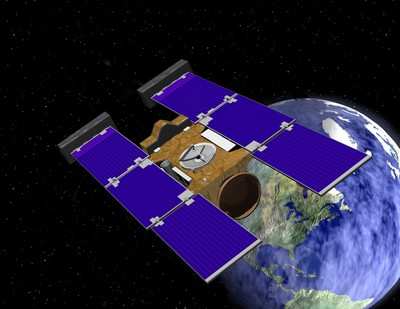Fuel Depleted, Mission Completed, Last Transmissions Sent
 NASA's Stardust spacecraft sent its last transmission to Earth
at 1933 EDT Thursday, March 24, shortly after depleting fuel and
ceasing operations. During an 11-year period, the venerable
spacecraft collected and returned comet material to Earth and was
reused after the end of its prime mission in 2006 to observe and
study another comet during February 2011.
NASA's Stardust spacecraft sent its last transmission to Earth
at 1933 EDT Thursday, March 24, shortly after depleting fuel and
ceasing operations. During an 11-year period, the venerable
spacecraft collected and returned comet material to Earth and was
reused after the end of its prime mission in 2006 to observe and
study another comet during February 2011.
The Stardust team performed the burn to depletion, because the
comet hunter was literally running on fumes. The depletion maneuver
command was sent from the Stardust-NExT mission control area at
Lockheed Martin Space Systems in Denver. The operation was designed
to fire Stardust's rockets until no fuel remained in the tank or
fuel lines. The spacecraft sent acknowledgment of its last command
from approximately 194 million miles away in space.
"This is the end of the spacecraft's operations, but really just
the beginnings of what this spacecraft's accomplishments will give
to planetary science," said Lindley Johnson, Stardust-NExT and
Discovery program executive at NASA Headquarters in Washington.
"The treasure-trove of science data and engineering information
collected and returned by Stardust is invaluable for planning
future deep space planetary missions."
After completion of the burn, mission personnel began comparing
the computed amount of fuel consumed during the engine firing with
the anticipated amount based on consumption models. The models are
required to track fuel levels, because there are no fully reliable
fuel gauges for spacecraft in the weightless environment of space.
Mission planners use approximate fuel usage by reviewing the
history of the vehicle's flight, how many times and how long its
rocket motors fired.
"Stardust's motors burned for 146 seconds," said Allan
Cheuvront, Lockheed Martin Space Systems Company program manager
for Stardust-NExT in Denver. "We'll crunch the numbers and see how
close the reality matches up with our projections. That will be a
great data set to have in our back pocket when we plan for future
missions."
Launched Feb. 7, 1999, Stardust flew past the asteroid named
Annefrank and traveled halfway to Jupiter to collect the particle
samples from the comet Wild 2. The spacecraft returned to Earth's
vicinity to drop off a sample return capsule eagerly awaited by
comet scientists.

Stardust NExT Spacecraft NASA Image
NASA re-tasked the spacecraft as Stardust-NExT to perform a
bonus mission and fly past comet Tempel 1, which was struck by the
Deep Impact mission in 2005. The mission collected images and other
scientific data to compare with images of that comet collected by
the Deep Impact mission in 2005. Stardust traveled approximately 13
million miles around the sun in the weeks after the successful
Tempel 1 flyby. The Stardust-NExT mission met all mission goals,
and the spacecraft was extremely successful during both missions.
From launch until final rocket engine burn, Stardust travelled
approximately 3.54 billion miles.
After the mileage logged in space, the Stardust team knew the
end was near for the spacecraft. With its fuel tank empty and final
radio transmission concluded, history's most traveled comet hunter
will move from NASA's active mission roster to retired.
"This kind of feels like the end of one of those old western
movies where you watch the hero ride his horse towards the distant
setting sun -- and then the credits begin to roll," said
Stardust-NExT project manager Tim Larson from NASA's Jet Propulsion
Laboratory in Pasadena, Calif. "Only there's no setting sun in
space."
Stardust and Stardust-NExT missions were managed by JPL for
NASA's Science Mission Directorate in Washington. The missions were
part of the Discovery Program managed at NASA's Marshall Space
Flight Center in Huntsville, Ala. Joe Veverka of Cornell University
was the Stardust-NExT principal investigator. Don Brownlee of the
University of Washington in Seattle was the Stardust principal
investigator. Lockheed Martin Space Systems built the spacecraft
and managed day-to-day mission operations.
 ANN's Daily Aero-Linx (04.16.24)
ANN's Daily Aero-Linx (04.16.24) Aero-News: Quote of the Day (04.16.24)
Aero-News: Quote of the Day (04.16.24) Airborne 04.10.24: SnF24!, A50 Heritage Reveal, HeliCycle!, Montaer MC-01
Airborne 04.10.24: SnF24!, A50 Heritage Reveal, HeliCycle!, Montaer MC-01 Airborne 04.12.24: SnF24!, G100UL Is Here, Holy Micro, Plane Tags
Airborne 04.12.24: SnF24!, G100UL Is Here, Holy Micro, Plane Tags Airborne-Flight Training 04.17.24: Feds Need Controllers, Spirit Delay, Redbird
Airborne-Flight Training 04.17.24: Feds Need Controllers, Spirit Delay, Redbird




